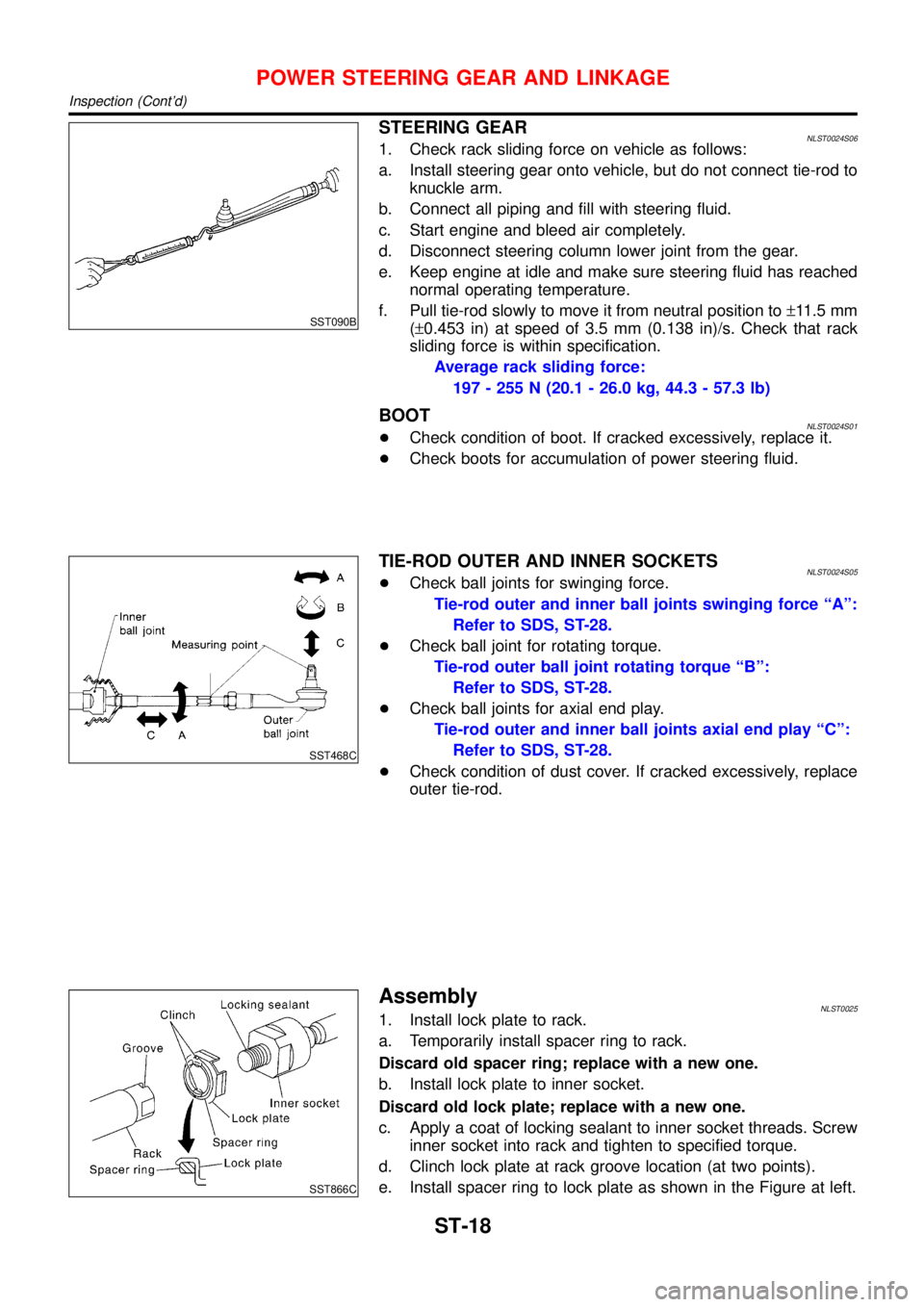2001 NISSAN ALMERA TINO air condition
[x] Cancel search: air conditionPage 2786 of 3051

Maintenance Under Severe Driving Conditions
(Annual Driving Distance > 30,000 km/year)
=NLMA0043S06The maintenance intervals shown on the preceding pages are for normal operating conditions. If the vehicle
is mainly operated under severe driving conditions as shown below, more frequent maintenance must be per-
formed on the following items as shown in the table.
A—Driving under dusty conditions
B—Driving repeatedly short distances
C—Towing a trailer or caravan
D—Extensive idling
E—Driving in extremely adverse weather conditions or in areas where ambient temperatures are either
extremely low or extremely high
F—Driving in high humidity areas or in mountainous areas
G—Driving in areas using salt or other corrosive materials
H—Driving on rough and/or muddy roads or in the desert
I—Driving with frequent use of braking or in mountainous areas
J—Frequent off road use or driving in water
K—Sustained high speed driving
L—For models without Euro-OBD system
Driving conditionMaintenance
itemMaintenance
operationMaintenance interval
ABCD........Engine oil & engine oil filter
Petrol models Replace Every 7,500 km (4,500 miles)
Diesel models Replace Every 10,000 km (6,000 miles)
A...........Air cleaner filter
Petrol models Replace Every 30,000 km (18,000 miles)
Diesel models Replace Every 30,000 km (18,000 miles)
A...E.......Fuel filter
Diesel models Replace Every 30,000 km (18,000 miles)
A...........Ventilation air filter
Petrol models Replace Every 15,000 km (9,000 miles)
Diesel models Replace Every 10,000 km (6,000 miles)
.....F......Brake fluid
Petrol models Replace Every 30,000 km (18,000 miles)
Diesel models Replace Every 30,000 km (18,000 miles)
..C....H....CVT fluid
Petrol models Replace Every 22,500 km (13,500 miles)
A.C...GHI...Brake pads, rotors & other brake system components
Petrol models Inspect Every 15,000 km (9,000 miles)
Diesel models Inspect Every 10,000 km (6,000 miles)
......GH....Steering gear & linkage, axle & suspension parts, drive shafts,
exhaust system
Petrol models Inspect Every 30,000 km (18,000 miles)
Diesel models Inspect Every 30,000 km (18,000 miles)
PERIODIC MAINTENANCE
Maintenance Under Severe Driving Conditions (Annual Driving Distance > 30,000 km/year)
MA-19
Page 2911 of 3051

SRS Component Parts LocationNLRS0011
NRS102
SRS797-A
Maintenance ItemsNLRS0012CAUTION:
Do not use electrical test equipment to check SRS circuit.
1. Check operation of“AIR BAG”warning lamp.
After turning ignition key to“ON”position,“AIR BAG”warning
lamp illuminates. The“AIR BAG”warning lamp will go off after
about 7 seconds if no malfunction is detected. If any of the fol-
lowing“AIR BAG”warning lamp conditions occur, immediately
check the air bag system. Refer to RS-45 for details.
+The“AIR BAG”warning lamp does not illuminate when the
ignition switch is turned“ON”.
+The“AIR BAG”warning lamp does not go off about 7 seconds
after the ignition switch is turned“ON”.
+The“AIR BAG”warning lamp blinks after about 7 seconds after
the ignition switch is turned“ON”.
2. Visually check SRS components.
1) Diagnosis sensor unit
+Check diagnosis sensor unit and bracket for dents, cracks and
deformities.
+Check connectors for damage, and terminals for deformities.
2) Air bag module and steering wheel
+Remove air bag module from steering wheel, instrument panel
SUPPLEMENTAL RESTRAINT SYSTEM (SRS)
SRS Component Parts Location
RS-20
Page 2931 of 3051

How to Perform Trouble Diagnoses for Quick
and Accurate Repair
=NLRS0044A good understanding of the malfunction conditions can make troubleshooting faster and more accurate.
In general, each customer feels differently about a malfunction. It is important to fully understand the symp-
toms or conditions for a customer complaint.
INFORMATION FROM CUSTOMERNLRS0044S01WHAT ..... Vehicle model
WHEN ..... Date, Frequencies
WHERE ..... Road conditions
HOW ..... Operating conditions, Symptoms
PRELIMINARY CHECKNLRS0044S02Check that the following parts are in good order.
+Battery [Refer to SC-3,“BATTERY”.]
+Fuse [Refer to EL-10,“Fuse”,“POWER SUPPLY ROUTING”.]
+System component-to-harness connections
SUPPLEMENTAL RESTRAINT SYSTEM (SRS)
How to Perform Trouble Diagnoses for Quick and Accurate Repair
RS-40
Page 2936 of 3051

SRS800
SRS Operation CheckNLRS0047DIAGNOSTIC PROCEDURE 1NLRS0047S01Checking Air Bag Operation by Using“AIR BAG”
Warning Lamp—User Mode
NLRS0047S01011. After turning ignition switch from“OFF”to“ON”,“AIR BAG”
warning lamp operates.
2. Compare“AIR BAG”warning lamp operation to the chart
below.
“AIR BAG”warning lamp operation—User mode—SRS condition Reference item
MRS095A
No malfunction is
detected. No further action
is necessary.
—
MRS096A
The system is malfunction-
ing and needs to be
repaired as indicated.Go to DIAGNOSTIC PRO-
CEDURE 2 or 6 (RS-46 or
RS-55).
MRS097A
Air bag or/and seat belt
pre-tensioner is deployed.Go to COLLISION DIAG-
NOSIS (RS-66).
Air bag fuse, diagnosis
sensor unit or harness is
malfunctioning and needs
to be repaired.Go to DIAGNOSTIC PRO-
CEDURE 9 (RS-63).
MRS098A
One of the following has
occurred and needs to be
repaired.
+Meter fuse is blown.
+“AIR BAG”warning
lamp circuit has open
or short.
+Diagnosis sensor unit is
malfunctioning.Go to DIAGNOSTIC PRO-
CEDURE 10 (RS-65).
NOTE:
If“AIR BAG”warning lamp operates differently from the
operations shown above, refer to“AIR BAG”warning lamp
operation—Diagnosis mode—, DIAGNOSTIC PROCEDURE 6
(step 4), RS-55.
SUPPLEMENTAL RESTRAINT SYSTEM (SRS)
SRS Operation Check
RS-45
Page 2947 of 3051

No.“AIR BAG”warning lamp flash pattern—Diagnosis mode—SRS condition
1
SRS333
athroughbare repeated.+Diagnosis
results (pre-
viously
stored in
the
memory)
might not
be erased
after repair.
+Intermittent
malfunction
has been
detected in
the past.
Go to DIAG-
NOSTIC PRO-
CEDURE 8
(RS-62).
2
SRS341
athroughdare repeated.
b—Driver and front passen-
ger air bag and front seat belt
pre-tensioner marker (For iden-
tifying driver air bag, front pas-
senger air bag and/or front seat
belt pre-tensioners malfunction-
ing)
d—Indicates malfunctioning
part. The number of flash var-
ies with malfunctioning part
(0.5 sec. ON and 0.5 sec. OFF
is counted as one flash.)The system is
malfunctioning
and needs to
be repaired.
3
SRS342-A
athroughfare repeated.
b,c,d—Front side air bag
marker (For identifying front
side air bag malfunctioning)
f—Indicates malfunctioning
part. The number of flash var-
ies with malfunctioning part
(0.5 sec. ON and 0.5 sec. OFF
is counted as one flash.)
7. Malfunctioning part is indicated by the number of flashes (part
dorf). Compare the number of flashes to“Air Bag Warning
Lamp Flash Code Chart”, page RS-57, and locate malfunction-
ing part.
8. Turn ignition switch“OFF”, and disconnect both battery cables.
9. Repair the system as outlined by the“Repair order”in“Warn-
ing Lamp Flash Code Chart”that corresponds to the flash
code. For replacement procedure of component parts, refer to
RS-21.
10. After repairing the system, go to DIAGNOSTIC PROCEDURE
7, page RS-60.
SUPPLEMENTAL RESTRAINT SYSTEM (SRS)
Trouble Diagnoses without CONSULT-II (Cont’d)
RS-56
Page 2952 of 3051

No.“AIR BAG”warning lamp flash pattern—Diagnosis mode—SRS condition
1
SRS333
athroughbare repeated. No malfunction
is detected or
repair is com-
pleted.
No further
action is nec-
essary.
2
SRS341
athroughdare repeated.
b—Driver and front passen-
ger air bag and front seat belt
pre-tensioner marker (For iden-
tifying driver air bag, front pas-
senger air bag and/or front seat
belt pre-tensioners malfunction-
ing)
d—Indicates malfunctioning
part. The number of flashes
varies with malfunctioning part
(0.5 sec. ON and 0.5 sec. OFF
is counted as one flash.)The system is
malfunctioning
and needs to
be repaired.
3
SRS342-A
athroughfare repeated.
b,c,d—Front side air bag
marker (For identifying front
side air bag malfunctioning)
f—Indicates malfunctioning
part. The number of flashes
varies with malfunctioning part
(0.5 sec. ON and 0.5 sec. OFF
is counted as one flash.)
NOTE:
When diagnosis sensor unit is replaced with new one,“AIR BAG”
warning lamp will operate in User mode. Checking“AIR BAG”
warning lamp operation in Diagnosis mode is not required. Go to
step 6.
5. If“AIR BAG”warning lamp operates as shown in No. 1 in chart
above, turn ignition switch“OFF”to reset from Diagnosis mode
to User mode and to erase the memory of the malfunction.
Then go to step 6.
If“AIR BAG”warning lamp operates as shown in No. 2 or No.
3 in chart above, the malfunctioning part is not repaired
completely, or another malfunctioning part is detected. Go to
DIAGNOSTIC PROCEDURE 6, page RS-55, and repair mal-
functioning part completely.
6. Turn ignition switch“ON”.“AIR BAG”warning lamp operates in
User mode. Compare“AIR BAG”warning lamp operation to
the chart on the next page
NOTE:
When a malfunction is detected, switch from Diagnosis mode to
user mode by turning the ignition switch as follows:
1) Turn ignition switch“ON”.
2) After“AIR BAG”warning lamp lights for 7 seconds, turn igni-
tion switch“OFF”within 1 second.
3) Wait more than 3 seconds.
4) Repeat steps 1 to 3 three times.
5) Turn ignition switch“ON”.
SRS is now in User mode.
SUPPLEMENTAL RESTRAINT SYSTEM (SRS)
Trouble Diagnoses without CONSULT-II (Cont’d)
RS-61
Page 2953 of 3051

“AIR BAG”warning lamp operation—User mode—SRS condition Reference item
MRS095A
No malfunction is
detected.
No further action is neces-
sary.—
MRS096A
The system is malfunc-
tioning and needs to be
repaired as indicated.Go to DIAGNOSTIC PRO-
CEDURE 6 (RS-55).
MRS097A
Air bag is deployed.
Seat belt pre-tensioner is
deployed.Go to COLLISION DIAG-
NOSIS (RS-66).
Air bag fuse, diagnosis
sensor unit or harness is
malfunctioning and needs
to be repaired.Go to DIAGNOSTIC PRO-
CEDURE 9 (RS-63).
MRS098A
One of the following has
occurred and needs to be
repaired.
+Meter fuse is blown.
+“AIR BAG”warning
lamp circuit has open
or short.
+Diagnosis sensor unit is
malfunctioning.Go to DIAGNOSTIC PRO-
CEDURE 10 (RS-65).
DIAGNOSTIC PROCEDURE 8 (CONTINUED FROM
DIAGNOSTIC PROCEDURE 6)
NLRS0049S03Inspecting SRS malfunctioning record
1 CONSIDER POSSIBILITY OF NOT ERASING SELF-DIAGNOSTIC RESULT AFTER REPAIRING
Is it the first time for maintenance of SRS?
YesorNo
Ye s©Go to DIAGNOSTIC PROCEDURE 5 (RS-51). (Further inspection cannot be performed
without CONSULT-II.)
No©Diagnosis results (previously stored in the memory) might not be erased after repair. Go
to DIAGNOSTIC PROCEDURE 7, step 5 (RS-60).
SUPPLEMENTAL RESTRAINT SYSTEM (SRS)
Trouble Diagnoses without CONSULT-II (Cont’d)
RS-62
Page 3013 of 3051

SST090B
STEERING GEARNLST0024S061. Check rack sliding force on vehicle as follows:
a. Install steering gear onto vehicle, but do not connect tie-rod to
knuckle arm.
b. Connect all piping and fill with steering fluid.
c. Start engine and bleed air completely.
d. Disconnect steering column lower joint from the gear.
e. Keep engine at idle and make sure steering fluid has reached
normal operating temperature.
f. Pull tie-rod slowly to move it from neutral position to±11.5 mm
(±0.453 in) at speed of 3.5 mm (0.138 in)/s. Check that rack
sliding force is within specification.
Average rack sliding force:
197 - 255 N (20.1 - 26.0 kg, 44.3 - 57.3 lb)
BOOTNLST0024S01+Check condition of boot. If cracked excessively, replace it.
+Check boots for accumulation of power steering fluid.
SST468C
TIE-ROD OUTER AND INNER SOCKETSNLST0024S05+Check ball joints for swinging force.
Tie-rod outer and inner ball joints swinging force“A”:
Refer to SDS, ST-28.
+Check ball joint for rotating torque.
Tie-rod outer ball joint rotating torque“B”:
Refer to SDS, ST-28.
+Check ball joints for axial end play.
Tie-rod outer and inner ball joints axial end play“C”:
Refer to SDS, ST-28.
+Check condition of dust cover. If cracked excessively, replace
outer tie-rod.
SST866C
AssemblyNLST00251. Install lock plate to rack.
a. Temporarily install spacer ring to rack.
Discard old spacer ring; replace with a new one.
b. Install lock plate to inner socket.
Discard old lock plate; replace with a new one.
c. Apply a coat of locking sealant to inner socket threads. Screw
inner socket into rack and tighten to specified torque.
d. Clinch lock plate at rack groove location (at two points).
e. Install spacer ring to lock plate as shown in the Figure at left.
POWER STEERING GEAR AND LINKAGE
Inspection (Cont’d)
ST-18